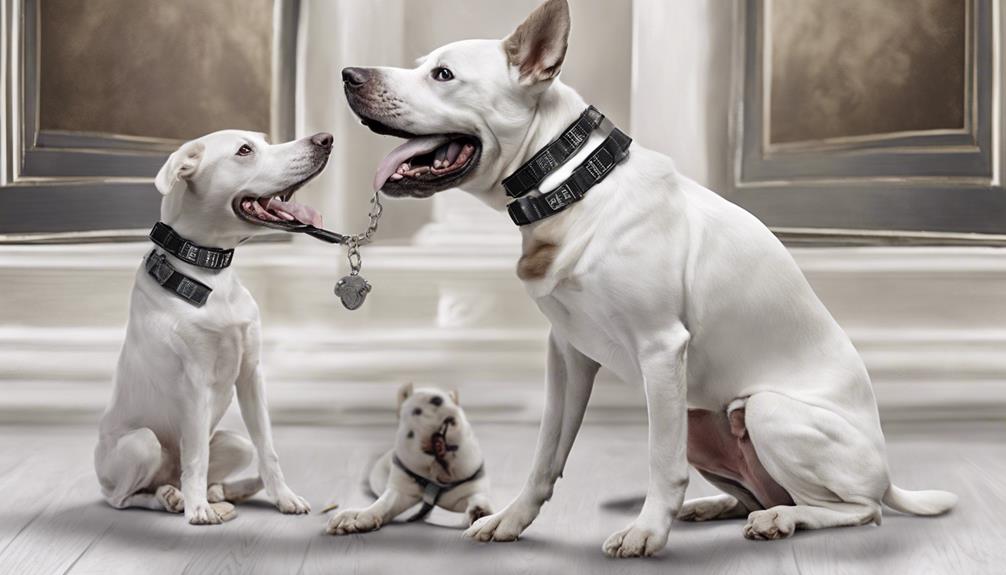When it comes to training our hearing-impaired canine friends, the phrase ‘patience is a virtue’ holds very true.
As we explore the world of vibrating collar training for deaf dogs, we uncover a method that holds promise in enhancing communication and understanding.
The journey to effectively utilizing this tool begins with a foundation of knowledge and guidance.
Stay tuned to discover how this step-by-step guide can pave the way for a deeper connection and successful training experience with your beloved deaf dog.
Key Takeaways
- Visual cues and vibrations are vital for training deaf dogs effectively.
- Start with short, positive training sessions in a secure environment.
- Consistency, patience, and positive reinforcement are crucial for successful training.
- Utilize hand signals, rewards, and gradual adjustments for optimal responsiveness.
Understanding Deaf Dog Behavior
Understanding how deaf dogs communicate and behave is crucial for their well-being and effective training. Deaf dogs heavily rely on visual cues and vibrations for communication, making it essential to incorporate these methods into their training routines.
Behavioral changes in deaf dogs can often signal hearing loss, highlighting the importance of recognizing and adapting to their unique needs promptly. When training deaf dogs, utilizing positive reinforcement techniques and consistent hand signals is key to successful communication and learning.
By focusing on touch-based methods and vibrations, trainers can effectively convey commands and build a strong bond with their deaf canine companions. It's vital to be patient, understanding, and consistent in training deaf dogs to ensure their comfort and success in learning new behaviors.
Embracing innovative approaches tailored to their specific needs can greatly enhance the training experience for both the dog and the handler.
Choosing the Right Vibrating Collar

When selecting a vibrating collar for your deaf dog, it's essential to consider factors such as adjustable vibration levels, durability, comfort, controls, and battery life to ensure effective and comfortable training sessions.
When choosing the right vibrating collar, keep in mind the following key features:
- Adjustable Vibration Levels: Look for collars that offer adjustable vibration settings to cater to your dog's sensitivity levels.
- Durability: Opt for a collar that's sturdy and well-made to withstand your dog's daily activities and ensure long-term use.
- Comfort and Fit: Prioritize a collar that's comfortable for your dog to wear and fits well to facilitate successful training sessions without causing discomfort.
Selecting a vibrating collar with intuitive controls and a good battery life will enhance the training experience for both you and your deaf dog, making the process smoother and more effective.
Introduction to Vibrating Collar Training
Navigating the world of vibrating collar training can be a transformative experience for both you and your deaf dog. When using a vibrating collar for training, it serves as a vital tool for communication, helping your deaf dog understand commands and focus their attention. It emits gentle vibrations that your dog can feel, creating a way to convey messages effectively.
To start, ensure your dog is comfortable wearing the collar in a safe environment. Begin training with short sessions, using treats to reinforce positive behavior. Make gradual adjustments to the collar's settings to find the right level for your dog's responsiveness. It's essential to approach training with patience and consistency, creating a bond built on understanding and trust.
Basic Commands and Training Techniques

As we move forward into discussing basic commands and training techniques, let's focus on the foundational aspects of communication and behavior shaping for deaf dogs. When training deaf dogs, using visual cues and positive reinforcement is essential. Consistency in applying these techniques helps deaf dogs understand and respond to basic commands like sit, stay, come, and watch me effectively.
Here are some key points to keep in mind:
- Utilize Visual Cues: Incorporate hand signals or other visual cues to communicate commands clearly.
- Employ Positive Reinforcement: Reward your deaf dog with treats, toys, or affection to reinforce desired behaviors.
- Practice Patience and Repetition: Deaf dogs learn through repetition, so be patient and consistent in your training sessions.
Advanced Training Strategies
Let's delve into advanced training strategies that can further enhance the communication and development of deaf dogs. When using a vibrating collar for training, incorporating hand signals alongside vibrations can help teach more complex commands like 'come' or 'look'. Consistent cues and positive reinforcement are crucial for continued learning. To challenge your dog's cognitive abilities, gradually increase the difficulty of the training tasks. The key is to focus on building a strong bond through tailored advanced training methods that cater to your dog's specific needs. Below is a table outlining some advanced training strategies using vibrations:
| Training Methods | Commands such as sit | Desired Action |
|---|---|---|
| Hand Signals | Signal for 'sit' | Dog sits |
| Vibration and Treats | Vibration cue | Dog performs action |
| Advanced Hand Signals | Complex gestures | Dog follows command |
Building Trust and Bonding With Your Dog

To strengthen the bond with your deaf dog, prioritize building trust through positive reinforcement and consistent training sessions. Using a vibrating dog collar as a valuable tool, along with these techniques, will help you effectively train your dog and establish a strong connection:
- Give your dog rewards: Use treats, toys, or praise to reward your deaf dog for good behavior. Positive reinforcement creates a positive association with training sessions.
- Train your dog in a quiet environment: Minimize distractions during training to help your dog focus on you and the commands you're giving. This will enhance communication and understanding.
- Teach your dog to come when called: Coming when called is an essential command for your dog's safety. Use the vibrating collar to signal your dog when they should return to you. Consistent practice will lead to successful training and a deeper bond with your furry friend.
Frequently Asked Questions
How Do You Train a Deaf Dog With a Vibrating Collar?
When training a deaf dog with a vibrating collar, we focus on using vibrations as cues for commands. The collar helps us get their attention without sound. We rely on repetition and positive reinforcement to teach them.
Starting in a quiet place helps them connect vibrations to actions. Once they respond well indoors, we gradually introduce outdoor training.
It's all about patience and consistency to help our furry friends learn effectively.
How Do You Train a Dog to Use a Vibrating Collar?
When training a dog to use a vibrating collar, we introduce the collar gradually, associating the vibration with positive experiences using treats and rewards.
Consistency in rewarding the desired response is crucial. Starting in a calm environment and gradually introducing distractions helps the dog understand the purpose of the vibration.
How Long Can I Leave a Vibration Collar on My Dog?
We should only leave a vibration collar on our dog for short, supervised training sessions. Extended wear can cause skin irritation or pressure sores. It's crucial to follow the manufacturer's guidelines on usage duration to prevent discomfort.
Always remove the collar when not actively training to ensure your dog's well-being. It's best to prioritize your dog's comfort and safety by using the collar responsibly during training.
Do Deaf Dogs Feel Vibrations?
Yes, deaf dogs do feel vibrations. Their heightened sense of touch allows them to pick up on vibrations, making it an effective way to communicate with them during training.
Vibrating collars are designed to alert and grab the attention of deaf dogs, serving as a tactile cue for them to respond to commands.
Using vibrations helps bridge the communication gap with deaf dogs, enhancing training and interaction.
Can Vibrating Collars Be Used for Training Deaf Dogs as Well?
Yes, the best vibrating dog collars can be used for training deaf dogs as well. Vibrating collars are a great tool for communication and teaching commands to dogs, regardless of their hearing ability. They provide a gentle vibration that can be felt by the dog, making it an effective training aid.
Conclusion
In conclusion, training your deaf dog with a vibrating collar is a journey of patience, understanding, and dedication.
Like a delicate dance between partners, it requires communication, trust, and mutual respect.
By following the steps outlined in this guide, you can create a harmonious relationship with your furry companion, leading to a bond that's as strong as a diamond in the rough.
Remember, with love and consistency, anything is possible.










